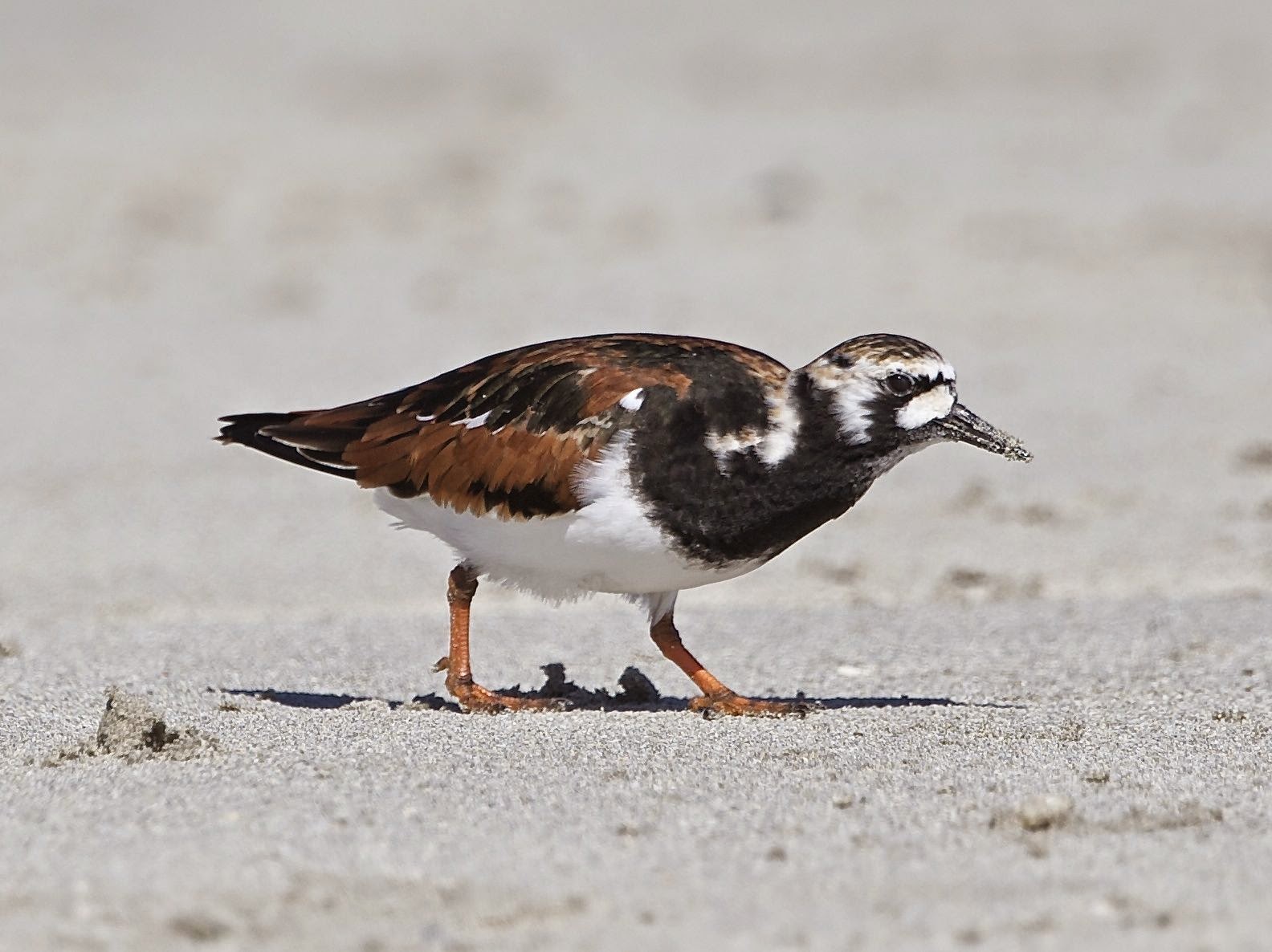Griffith Island is a significant
Short-tailed Shearwater breeding site located on the edge of the historic Port
Fairy township. The geology of the island and surrounding region is dominated
by volcanic activity. Tower Hill and Mt Eccles, which both have lakes within
their craters, and Mt Napier, are all extinct volcanoes located a short
distance from Port Fairy.
While walking around the island we came
across some Ruddy Turnstones working their way along black basaltic rocks beside
the ocean.
 |
| Ruddy Turnstones making their way along large basalt rocks beside the ocean as waves splashed up. |
Ruddy Turnstones, Arenaria interpres, are widespread across the world. Subspecies interpres is found in Australia and
breeds in eastern Siberia and Alaska.
Rarely found on tidal mud flats, these
birds have evolved to exploit sandy and rocky ocean beaches. They can be found all
around the Australian coast, which is where they are most often seen, though
some may move inland. They are well described in Shorebirds of Australia
as “medium
sized, stocky shorebirds with distinctive plumage, short legs and wedge shaped
bill “.
As the name implies, when feeding they are often seen using their stout bills to turn over stones, shells and seaweed to
reveal invertebrate food beneath. Their distinctive shape and plumage colour
plus the dull orange short legs makes this shorebird species easy to identify –
they are unlikely to be confused with any other species.
 |
| One bird pauses on a rock. |
 |
| The birds were interested in the seaward side of the rocks and were mostly out of sight. However as waves broke they appeared on top when a few photos were possible. |
I was just getting excited about capturing
some more photos of the Turnstones on the striking black rocks when something
spooked them and they were off in a flash at speed to some point further along
the shore.
Moving on with the walk around the island,
I found a lovely small rock-enclosed sandy beach with about 20 Turnstones
busily feeding among the beach-washed seaweed.
 |
| Looking along the rocky shore towards the Port Fairy Lighthouse and an enclosed sandy beach. |
 |
| The enclosed sandy beach where we found about twenty Ruddy Turnstones feeding. |
The birds were excavating the sand nearly
to the full depth of their bills. They must have been finding food because they
all kept this up with great energy. At this late stage in the Australian summer
season, these birds, if migrating north to Siberia or Alaska, will need all the
fat reserves they can store for this long and arduous journey. Not all birds
migrate as some non-breeding birds, including some birds in breeding plumage,
over-winter here.
I approached the feeding birds slowly in
stages and stopped at a relatively close distance and waited. They soon settled
and as they fed some birds worked their way even closer to me giving plenty of
opportunity for photos and close observation.
 |
| Some of the Turnstones feeding. |
 |
| A closer view of a group foraging. While their movements seemed somewhat random they did generally all move in the same direction and more or less stayed together. |
 |
| All of the birds in the group were excavating the sand in search of food. No turning, just digging! |
 |
| This bird was showing more breeding plumage than most of the others. |
 |
| Same bird as above. |
 |
| Another bird, this one I think has non breeding plumage. First and second year birds and birds in partial moult all add to the range of colour options that might be encountered. |
 |
| This bird is tilted forward as it digs in the sand making it look even more stocky than normal. This bird may be a sub-adult? |
 |
| They all had sand on their bills which were inserted nearly full length into the sand. This one has just swallowed a food item. |
 |
| They all continued to feed as if there was not a moment to be wasted. |
 |
| After a while a few moved to the water to wash their bills. This shot shows the bill has a slight upturned appearance from some angles. |
The session watching and photographing the
Ruddy Turnstones ended when some people came onto the beach. Most noticed me
photographing the birds and moved quietly by at a distance but some paid no
attention at all.
After a few weeks of photographing birds in
overcast conditions it was a joy to finally find an attractive species in full
blue-sky and sunlight for a change. I hope you enjoyed the images.
PS. We returned to Griffith Island just after
sunset to see if any adult Short-tailed Shearwaters were coming in to feed the
young in their burrows. We watched until well after dark but only saw six or so
birds come in - there would be thousands in the peak of the season. We may have
been there too early and maybe more might have come in well after dark, or
perhaps the few we saw were just the late breeders and the bulk of the adult
birds have already departed, leaving the young to fend for themselves?
No comments:
Post a Comment